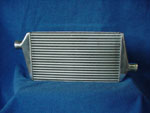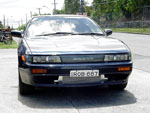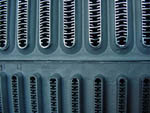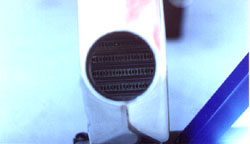| Ok, so you've stumbled onto our site, and have
found some really interesting stuff, but you've go one problem...What
the hell is an intercooler???? You see them hanging down from the
front of turbocharged cars all the time, but what do they do, are they
just for pose value.


What does a Intercooler Do?
A intercooler cools air. There, is that basic enough!!
Intercoolers are used in forced induction cars (turbocharged, or
supercharged) so that the compressed air from the turbocharger (or
supercharger) is cooled before it enters the engine.
Turbocharging and Supercharging
There is one reason why people turbocharge or supercharge an engine,
more power. In very basic terms, both turbocharging and
supercharging an engine create more power by forcing compressed air into
the engine. More air, means more oxygen, which means more power.
However, it should be noted that it is not the amount of air, per sa,
that determines the power, more the density of the air. The
colder the air, the more dense it is.
During the forced induction process the air is
heated up. Not because of the turbo housing is hot (although it is
hot, bloody hot!!) but because air is heated when compressed. Hot
air leads to two main problems. Firstly it is not as dense as cold
air, and secondly it can lead to detonation, and that my friends
is a expensive explosion.
Thus if the air can be cooled between the turbo or
supercharger and the engine it will be denser, colder air that will make
more horsepower.
Air Temp Increases
There are several factors that effect the extent to which air will
be heated:
- Boost - the higher the boost, the more the
compression the hotter the air.
- Efficiency of the compressor - the reason why a
turbo must be matched to the engine.
- Heat Sink - engine bays are hot places, and the
air can be heated more by heat sink though the plumbing from the
turbo to the engine.
- Ambient temperature - obviously, the hotter the
original temp of the air, the hotter it will end up being after
compression.
Intercooler Efficiency
There are two main concerns when reviewing the
efficiency of an intercooler
- Temperature Drop - a intercooler rated at 100%
efficient would cool the compressed air to ambient temperature.
- Pressure Drop - a intercooler should be
designed so to minimize pressure drop. A perfect intercooler
would have no pressure drop, however this is impossible to
obtain in reality.
Intercoolers
There are two different methods of intercooling an engine:-
Air to Air Intercoolers

Air to Air Intercoolers are by far
the most common method of intercooling. They are cheap, reliable,
and less complex than their air-to-water brethren. Air to air
intercoolers work by passing the intake charge into a end tank that
distributes the air evenly across the core, allowing it to pass down
tubes and then back out the other end tank and onto the engine.
The air is passed down the tubes, thus a large contact area, and heat is
transferred from the air into the aluminium wall of the tubes.
Outside air is passed through fins that zig zag between the tubes of the
intercooler, and thus cool the tubes. The air passing through the
intercooler, cools the tubes down, in turn cooling the intake air down.
The area between the tanks of the intercooler is called the core.

There are two types of cores used in air to air
intercoolers: tube and fin or bar and plate.


 |
| A
sample of cores from the perspective that you can't see, but
very important to what the intake charge see's! 2 are tube/fin
the rest are bar/plate. |
Tube an
d fin design |
Bar and
Plate design |
|

|

|
|
The internals of an intercooler
Bar and plate (on left) Vs. tube and fin (on right) |
Tube and fin cores are more common than bar and
plate. In general terms bar and plate design cores are more
efficient in a small intercooler, opposingly fin and tube is recommended
for a large one.
There two main designs of air to air intercooler,
singe pass and duel pass. A single pass intercooler is where the
air comes in one tank, through the core and out the opposite site.
A duel pass intercooler, is when the air come in one side, across the
intercooler, turns around and comes back through the tubes and exits the
same side as it entered.
A air to air intercooler should be placed where it
receives maximum air flow.
Air to Water Intercoolers

For maximum efficiency a air to water intercooler
is the only way. An air to water intercooler can in fact have a
better than 100% efficiency rating.
A air to water intercooler is a more complex
design than a air to air. It incorporates a radiator, pump, and
the intercooler itself. Unlike the air to air intercooler that
only has one circuit of flow, i.e air, a air to water has two seperate
flow cycles, the air and the water.
The air follows basically the same path as with a
air to air intercooler, ie. from the turbo, through pipes to the
intercooler, through the intercooler and then plumbed through to the
intake manifold.
However, there is also a water circuit involved in
a air to water intercooler. The water is pumped from the
radiator (a completely different entity to the normal radiator, with a
completely different water supply) up into the intercooler, and then
back to the radiator. A optional ice box may be added
between the intercooler and the radiator, where by the water passes
through a special built 'esky' like container that chills it before it
returns to the radiator.
Air to water intercoolers are placed at the
highest point in the engine bay.
The intercooler assembly itself, is in the most
basic of definitions, a air to air intercooler encased in sheet metal.
The intake charge passed through like it normally would, however instead
of using outside air to pass though the fins, water is used. It is
pumped up to the top of the intercooler and then flows down through the
finds, pass the tubes and out of the unit.
|

The Components - what it takes
to make an air to water 'cooler?
NB. radiator, ice box & pump not shown
|

The ARE custom air to water
intercooler. Sure going to
need HPC on the exhaust here!
|
* Also see - Project Rodeo
- for more R&D work on air to water intecoolers
- Bar/Plate or
Fin/Tube for more info on air to air intercoolers
|